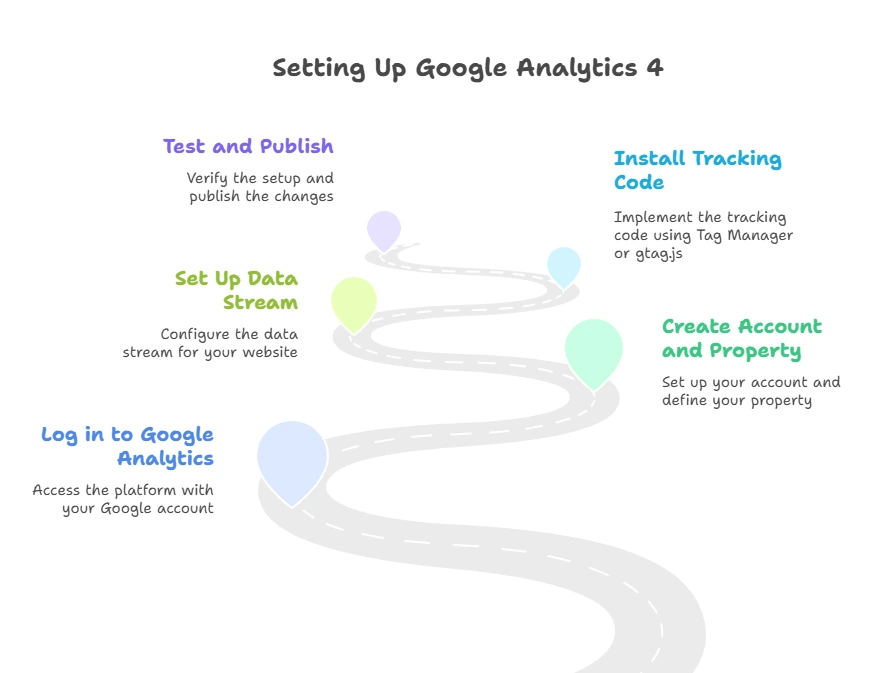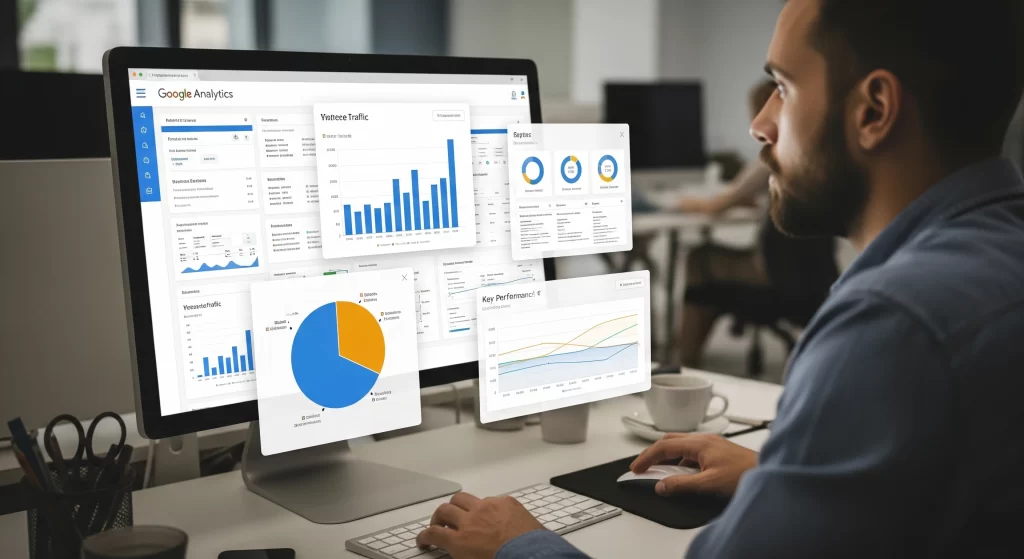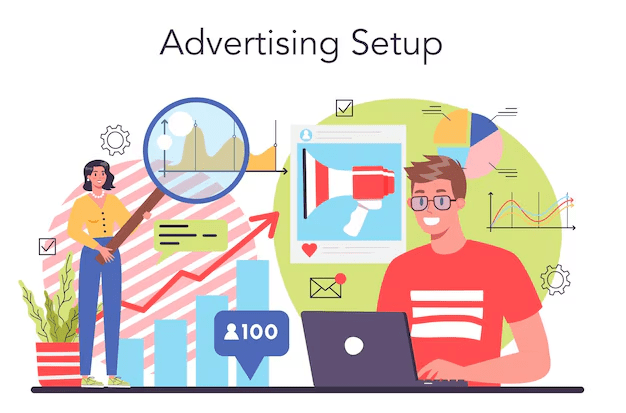Anyone who’s into marketing is likely to have heard(or maybe read) about Google Analytics. But is it relevant? Absolutely. 14.8 million websites are utilizing GA to make informed decisions. It is a very important part of marketing, and through this blog, we, as the best SEO marketing company in India, will teach you how to use Google Analytics from scratch.
Moreover, you’ll learn: does Google Analytics cost money, how to set up Google Analytics, does Google Analytics use cookies, and how to use Google Analytics to improve SEO?
So, let’s begin!
What Is Google Analytics?
Google Analytics(GA4) is a very useful tool that is used in marketing to collect data from your website and apps.
This tool then transforms it into detailed reports and insights about how people interact with your content.
Why are we saying it’s useful? Because it helps the users understand the audience, measure performance, and make data-driven decisions.
History in a Nutshell
Originally launched as a free service after Google acquired Urchin, Google Analytics provided webmasters with a hassle-free way to monitor site traffic. Since then, it has evolved enormously.
Is Google Analytics Free? (and Does Google Analytics Cost Money?)
There are three versions of it:
The Free Version
Yes, Google Analytics can be used without paying a penny. The standard version (Google Analytics 4, or GA4) is available to anyone with a Google account and offers robust tracking features, like real-time data, event tracking, custom dashboards, and audience segmentation.
The Hidden Costs
While there’s no financial cost for the standard version, there are indirect or “time” costs. For example, for setting the Google Analytics for your business, you might need to hire a developer or a consultant for help. Data sampling, data retention limits, privacy compliance, and lack of direct support can also present challenges.
Google Analytics 360 (Premium Paid Version)
For enterprises needing more advanced features, there’s Google Analytics 360, the premium tier. It starts at roughly $150,000/year for expanded data limits, unsampled reports, faster data processing, priority support, and SLAs.
In short:
- Is Google Analytics free? Yes (standard GA4).
- Does Google Analytics cost money? Only if you opt for the enterprise-level GA 360, which is extremely pricey.
Does Google Analytics Use Cookies?
Yes, Google Analytics uses cookies extensively. It relies on JavaScript libraries that set cookies to track interactions, remember visitor behavior across pages, and measure how users engage with your site.
Because of this, visitors with cookies blocked or cleared may not be tracked accurately.
Privacy rules like GDPR have made people worry about how Google Analytics stores and shares data. In the EU, some regulators have even limited the use of GA4 unless extra safety steps are taken.
How to Set Up Google Analytics (GA4) Step by Step
Let’s walk through how to set up Google Analytics from scratch.

Graphic 1.1. Infographic showing Steps to set Google Analytics
Create an Account & GA4 Property
- Go to analytics.google.com and log in with your Google account.
- In Admin, click Create Account, name it, and define your property (like your website). Set your time zone and currency
Set Up a Data Stream
- Within that property, create a web data stream by entering your site’s URL and name. Enable Enhanced Measurement to automatically track common events like pageviews, scrolls, and file downloads.
Install the Tracking Code via Tag Manager or gtag.js
- Copy your Measurement ID.
- Option A: Use Google Tag Manager, create a new tag, choose Google Analytics 4 configuration, paste your Measurement ID, and set it to fire on all pages.
- Option B: Or insert the GA4 global site tag (gtag.js) directly into your website’s <head> section.
- Use GA4’s DebugView to test, then publish your changes.
Navigating the GA4 Interface: What to Look At First
Learned how to set up Google Analytics? Now, here are the next things to explore in GA4 dashboard:
Home Dashboard
Your Home offers an overview of key metrics: user count, sessions, engagement time, revenue (if applicable), and real-time insights like users per medium and automated suggestions.
Realtime Reports
Check live activity: visitor locations, current pages viewed, and sources in the Realtime section.
Core Reports
- Acquisition: Where users come from (e.g., Google search, social media).
- Engagement: What they do, event tracking, average time, pageviews.
- Retention & Monetization: Useful for tracking loyalty and revenue (if relevant).
Demographics & Tech
Discover users’ locations, devices, browsers, and operating systems.
Top Pages & Events
See your most visited pages, total views, and engagement events like page_view, scroll, and click.
Insights & Exploration Tools
- Insights: AI-generated alerts (like spikes or drops) appear automatically.
- Explore: Advanced tools for custom funnels, pathing, and deeper analysis.
Admin Section
From Admin, adjust property settings, data retention spans, conversions, integrations, and more.
How to Use Google Analytics to Improve SEO?
You’ve gathered all the data now, every sort of report is on your screen, thanks to GA4. Done? Not yet, if you want to use the data & learn how to use Google Analytics to improve SEO, keep reading. Things you need to do next to make a difference using GA4:
Understand Organic Traffic Performance
Under Acquisition, check how much of your traffic comes through organic search. Monitor trends and sources to see which keywords bring users (in integration with Google Search Console) and which pages are performing best.
Identify Your Top Performing Pages
Check the Engagement and Pages reports to find your most popular pages and the ones people leave quickly. Then improve the weak ones.
Track User Behavior Signals
High session duration and low bounce rate often indicate that content is resonating. If you notice pages ranking but with low engagement, it’s a cue to improve content or UX.
Improve Conversion Paths
Define SEO success by setting goals or marking certain events as conversions (e.g., newsletter signup, form fill). Then you can see what organic traffic leads to conversions.
Spot Content Gaps
Look at pages with partial traffic. If visitors land on them and leave quickly, or don’t convert, it may indicate missing information or unclear navigation.
Regular Reporting & Adjustments
Keep an eye on your site using insights and custom dashboards. If your Google traffic goes down, check for SEO issues, outdated content, or Google updates.
Avoid the Analytics Rabbit Hole: Stay Focused
GA4 is powerfull, but that also means it can overwhelm you with data. Start small:
- Stick to core metrics: user sessions, engagement time, top pages, traffic sources.
- Define 2–3 main goals based on your business (e.g., traffic growth, leads, sales).
- Monitor weekly or monthly, not obsessively hourly.
- Ask: “What seems to matter most to me right now?”
Final Thoughts & Next Steps
Congratulations! You’re now equipped to use Google Analytics from scratch! Here’s a quick plan for what to do next:
- Set it up: Follow steps to install GA4 on your site.
- Explore reports: Familiarize yourself weekly with acquisition, engagement, real-time data.
- Define goals: Choose 1–2 KPIs (e.g., increasing organic traffic or form submissions).
- Optimize content: Use page-level insights to update content, calls to action, or layout.
- Stay consistent & focused: Avoid data overload; run targeted checks based on your goals.
In case you’re looking for the best digital marketing company in Delhi, say the name “Wildnet Technologies”. Connect today.
FAQs
1. What is Google Analytics and how does it help websites?
Google Analytics (GA) is a free to use tool that shows how people use your website. It tracks things like which pages they visit, how long they stay, where they come from, and who they are. Instead of just numbers, it gives clear insights to improve your content, marketing, and overall website experience, so you can get more visitors and turn them into customers.
2. What is the difference between GA4 and Universal Analytics (UA)?
GA4 replaces UA with a new, event-based tracking model. Unlike UA’s session-centric approach, GA4 tracks everything as “events” with flexible parameters. It supports cross-platform tracking, web and app, and emphasizes privacy and predictive insights powered by machine learning.
3. Do I need to install a new tracking code for GA4?
Yes. GA4 uses a different measurement ID (starting with “G-”), requiring a fresh implementation via Google Tag Manager or directly on your site. UA tags can’t be repurposed, you must implement GA4 separately while optionally maintaining UA until its deprecation.
4. Is Google Analytics free to use?
Yes. The standard version of Google Analytics is completely free for most users. Google also offers a paid, enterprise-level version—Google Analytics 360—with expanded capacity and features for large businesses.
5. Why don’t I have a bounce rate in GA4 anymore?
GA4 replaces the “bounce rate” metric with “engagement rate.” This reflects user behavior more meaningfully: If a visitor lasts on your website for more than 10 seconds, it means they “engaged” includes multiple page views, or results in a conversion, rather than simply tracking exits.
6. What are metrics versus dimensions in GA?
In Google Analytics, metrics are the numbers you track, like sales, visits, or revenue. Dimensions describe those numbers, like the city visitors came from, the device they used, or the traffic source. Metrics show “what happened,” and dimensions show “where or how it happened.”
7. Can I track both apps and websites in GA4?
GA4 lets you track both website and app activity together. So if someone visits your site on a laptop and later buys from your app, GA4 shows it as one journey, not two.
8. What happens to my UA reports and data?
GA4 doesn’t import UA data or reports because of its different data structure. UA stopped collecting data on July 1, 2023. You should export any historical UA data for archival or analysis purposes before Universal Analytics becomes inaccessible.
9. Does GA4 use views like Universal Analytics?
No, GA4 does away with “views.” Instead, it uses Data Streams (e.g., web or app) within properties. You can still filter data, but the structure is simpler—just account and property levels, for managing data collection settings.
10. How accurate is GA4 data?
GA4’s data can be affected by bot filtering, privacy settings, and modeling (especially when certain data is missing). Google uses machine learning to estimate insights, meaning the data may not be 100% precise, but it provides reliable, actionable trends for analysis.
Read More:






